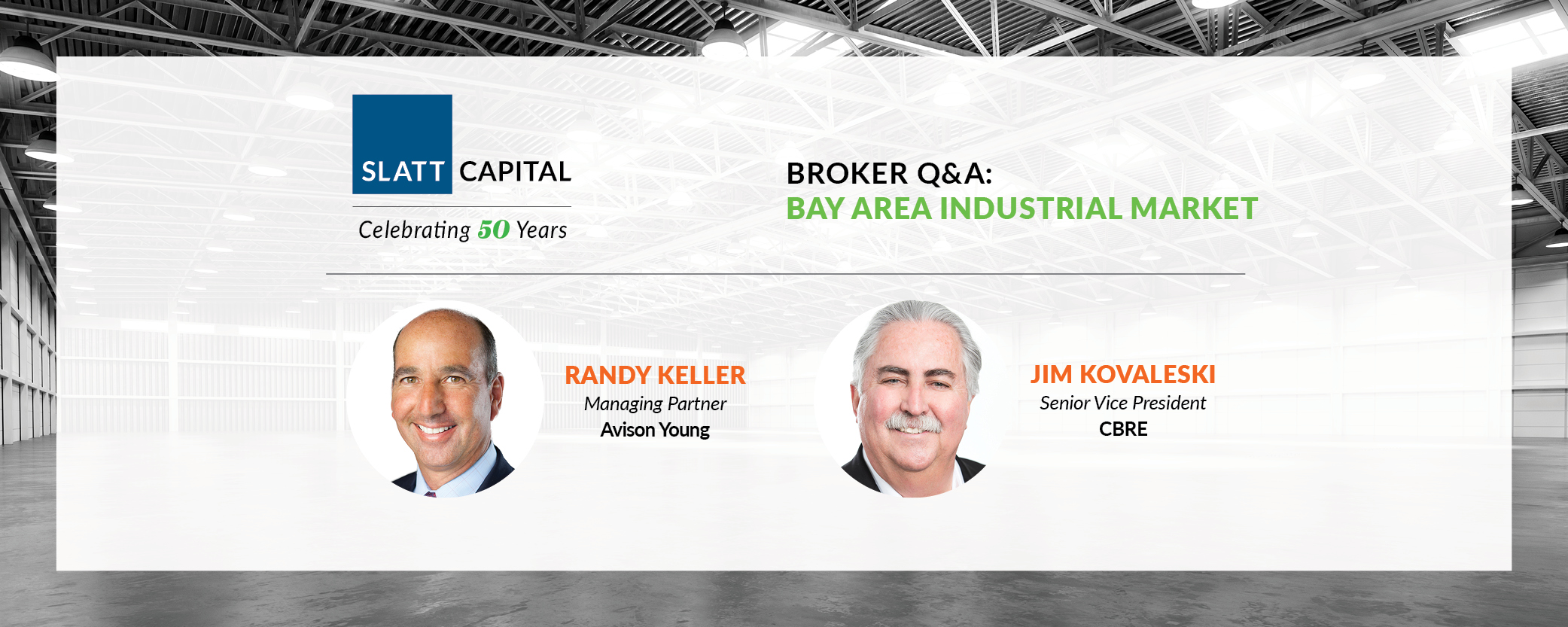
Broker Q&A: Bay Area Industrial Market
Slatt Capital Vice President David Bruni recently connected with Bay Area industrial brokers Randy Keller of Avison Young and Jim Kovaleski of CBRE to discuss the current state of the Bay Area industrial market. The following are each broker’s responses to questions on the current state and future of the industrial space as we emerge from the pandemic.
Industrial real estate remains in high demand as the pandemic fast-tracked the existing trend of e-commerce and last-mile delivery; with the pandemic easing, what is the demand for logistic industrial?
Jim Kovaleski, CBRE
During Q1 2021, demand for the logistics and distribution industry was responsible for 35% of total leases in the Bay Area, largely due to multiple deals in Newark, California. Speedy expansion from within logistics serving e-commerce has kept supply level very low throughout the market. With merging supply constraints and a rise in economic activity, lease rates could see upward momentum if conditions remain unchanged.
Randy Keller, Avison Young
There is a consensus among many that there has been a fundamental shift in the behavior patterns of consumers due to the pandemic. The older generation previously was more hesitant to use the internet and purchase through e-commerce sites; however, the pandemic changed this hesitancy and now this generation has fully adopted shopping online, whether for groceries, clothes, etc. This new pattern is now more mainstream so expect this shift to continue to grow into a long-term phenomenon, thus continuing the increase in demand for logistic requirements.
What changes are you seeing with respect to tenant desired property features in new construction, and is supply able to meet demand?
Randy Keller, Avison Young
New construction requirements from historical ones require higher ceilings, ESFR sprinkler systems, additional power for robotic and manufacturing uses, significantly increased parking ratios for both cars and trailer parking, and the usual proximity to freeways and employee base. Supply can meet demand in areas where there is abundant and cheap land to develop but is having issues in more dense cities and urban environments where costs of facilities and land do not make sense for redevelopment.
Jim Kovaleski, CBRE
Logistics and distribution tenants’ needs are being met with new construction offering higher clear heights for stacking inventory and increased parking for trailers. New product geared toward modern industrial uses commands a premium and could begin to lift pricing as more projects are delivered to the market. Demand for industrial space, paired with preleased construction projects, is anticipated to apply downward pressure on vacancy and increase net absorption figures.
With more and more industrial being demolished and entitled for multifamily and office, what are the long-term effects on the San Francisco Bay Area?
Jim Kovaleski, CBRE
For the third straight quarter, the Silicon Valley industrial market experienced positive net absorption. In Q1 2021, Fremont/Newark was the leading submarket, accounting for nearly 60% of all industrial transactions and recording 561,361 square feet of occupancy gains. The Silicon Valley industrial market has one of the highest average asking lease rates in the country.
Randy Keller, Avison Young
There will be a continuation of the trend to replace older and less functional industrial properties with the higher and better uses, whether it’s life science, residential, or commercial. Due to land pricing being so high and strong demand from these other sectors, there will be little new construction of industrial in the Bay Area moving forward into the future. This should allow for quality industrial properties to continue to increase in value over time and supply to diminish.
What is the trend in leasing and sales volume since the easing of Covid restrictions in 2021
Randy Keller, Avison Young
Within the Bay Area, sales volume is low as the demand to sell properties is limited even though prices are at a premium and demand to purchase is high. Sellers do not think there are better investment opportunities available compared to their existing property. Since there is limited new development, this also creates a low supply of sale opportunities.
After COVID-19 restrictions were lifted leasing volume has started to pick up for most companies. During the pandemic, the vast majority of activity was solely due to e-commerce companies needing space. Other companies were negatively impacted. Food-related companies that supply restaurants, corporations, etc., have started to recover. Hopefully, we are nearing recovery for all companies, and as businesses get back to normal, demand will continue to increase.
Jim Kovaleski, CBRE
As the region’s largest firms layout plans for their employees to safely return to the workplace, competition for industrial product is expected to increase due to a rise in traditional economic activity. Upward pressure on lease rates seems likely due to tight market fundamentals.
Industrial sales volume appears to have rebounded in 2021, with roughly 50 deals closing in the first quarter alone. Asset values remain on an upward trajectory even through the COVID-19 pandemic.
Contributors:
Randy Keller
Managing Director
D: 650.425.6420
randy.keller@avisonyoung.com
Jim Kovaleski
Senior Vice President
D: 408.453.7400
jim.kovaleski@cbre.com
Interviewer:
David Bruni
Vice President
D: 650.409.8108
dbruni@slatt.com